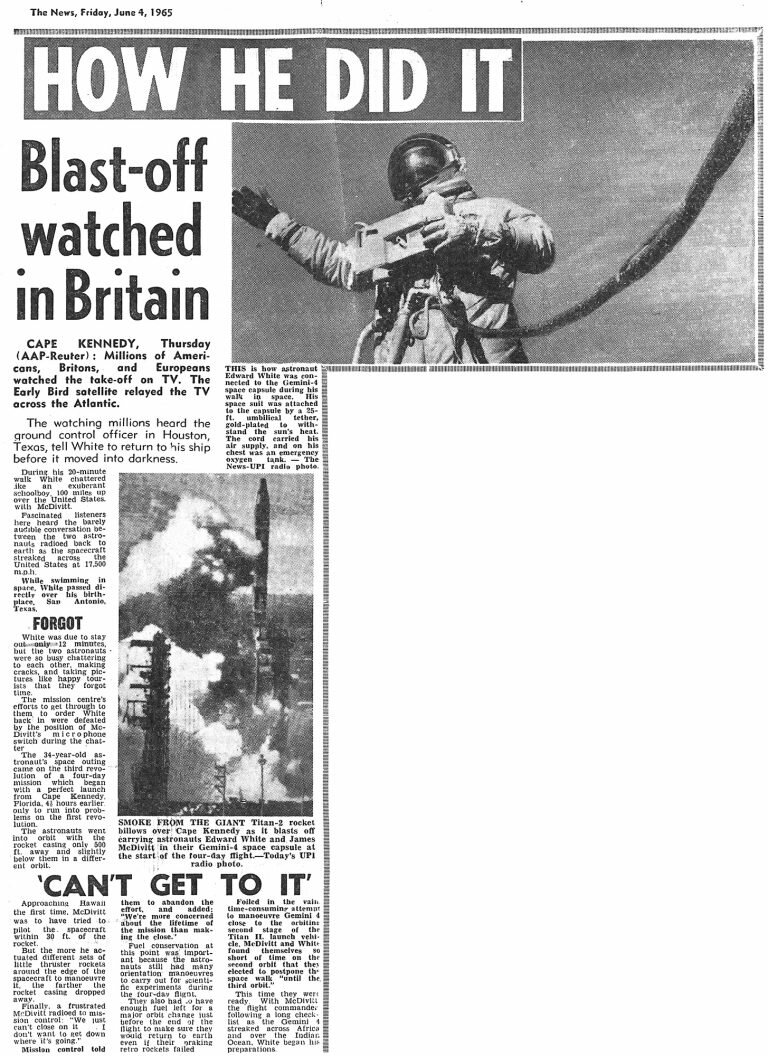Last updated June 1, 2018 at 3:59 pm
On 3 June 1965, Ed White emerged from the Gemini capsule to become the first US astronaut to perform a spacewalk.

White snapped outside of the capsule during the first US spacewalk. Credit: NASA
The Gemini 4 mission, crewed by Ed White and Jame McDivitt, set several firsts, but it will forever be remembered as the first US spacewalk.
After launching from Cape Canaveral, it was the first NASA mission to be controlled from the Mission Control Center in Houston, Texas. The launch itself was historic, being able to be watched internationally, live, for the first time.
Gemini 4 was to be the United States’ first multi-day mission, spanning 4 days and 66 orbits of Earth. During that time the astronauts conducted work on eleven scientific experiments, making it the first scientific US mission.
However, the highlight of the mission was the first spacewalk conducted by a US astronaut.
The spacewalk
Originally planned for the third orbit, the walk was delayed until the fourth after McDivitt suggested White rest to recover from the stress of launch and a failed manoeuvre.
While passing over Western Australia they began depressurising the spacecraft, and over Hawaii turned the latch to open the door. However the door would not budge.
Luckily McDivitt had been talking with an engineer during ground tests and seen a potential design flaw with the door where a spring failed to compress correctly. Having seen what could be causing the issue, he was able to come up with a solution on the spot to open and then safely re-close the door when White returned.
White floated free from the capsule tethered by an umbilical cord, holding a Hand-Held Maneuvering Unit, nicknamed the zip gun, which expelled compressed oxygen as a means of controlling his movement.
The astronauts had to deal with another unexpected problem. The mission was the first to use a voice-operated switch on their radio, however while in this mode McDivitt couldn’t hear CAPCOM at ground control. After switching to voice-operated mode as White exited the space craft, it would be 13 minutes before he realised the problem and switched the radios back to push-to-talk and regain communications with Earth.
Further complicating the issue was that White, while outside the spacecraft, couldn’t communicate with ground control at all, and needed all messages to be relayed through McDivitt.
After 20 minutes of spacewalk White reluctantly returned to the spacecraft after running out of excuses to remain outside, well past the planned 12 minute duration. To extend his time he and McDivitt had continued chatting and joking on an internal loop to prevent CAPCOM messages from being received, and found reasons to take more photographs, however eventually ground control ordered him inside.
Returning to the capsule he said “This is the saddest moment of my life.”
After securing the stubborn hatch, the astronauts powered down spacecraft systems to conserve fuel, entering a drift for the next two-and-a-half days.
Prior to re-entry the onboard computer failed, causing an embarrassment for IBM who had trumpeted their involvement in the space program. This required a change of reentry profile, changing to a rolling re-entry as used by the Mercury missions.
They reentered Earth’s atmosphere on June 7, and touched down in the North Atlantic Ocean, 65km short of their intended target.
How the Australian newspapers reported it at the time (click to enlarge).
The News, Friday 4 June
The Advertiser, Friday 4 June
The Advertiser, Saturday 5 June






























































































































































































































































































































































































































































































